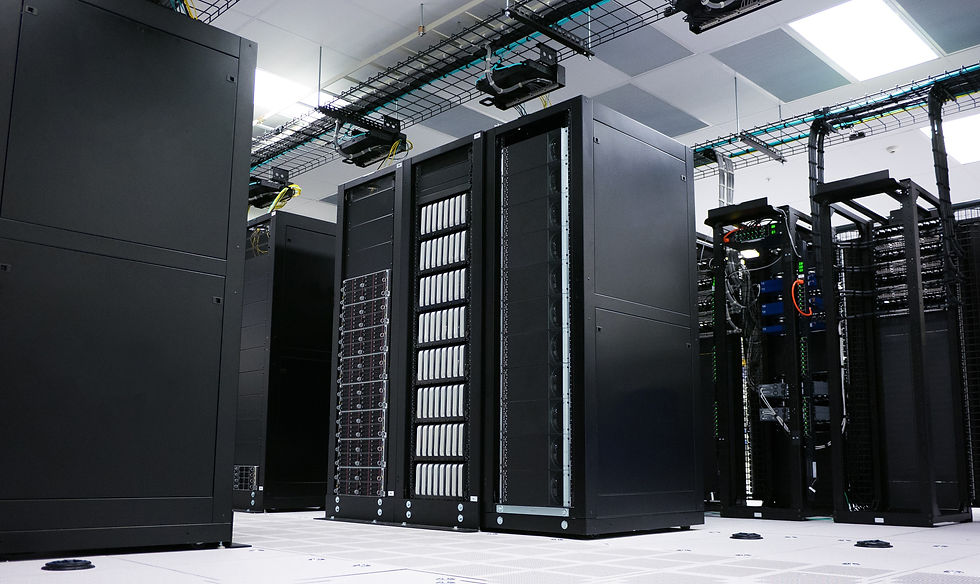Green Data Storage: Paving the Way for Sustainable Digital Futures
Let's face it... It's practically impossible to avoid data storage in today's digital age, it is at the core of our lives - from personal photos to critical business documents, our digital footprint is constantly growing. Another fact is that we are continuall
As the volume of data continues to explode, so does the energy consumption associated with data storage. This rising energy consumption has serious environmental consequences, including increased carbon emissions, air pollution, and resource depletion.
Fortunately, there's a greener path to data storage, one that's aligned with the principles of sustainability and environmental responsibility. In this article, we'll delve into the world of "Green Data Storage" and explore how renewable energy sources, energy-efficient hardware, and innovative technologies are reshaping the landscape of digital storage.

The Carbon Conundrum of Data Storage: Understanding the Environmental Impact
Behind the scenes, however, lies a silent but significant environmental challenge: the carbon footprint of data storage is growing at an unsustainable rate. As our reliance on data continues to surge, it's crucial to explore the carbon conundrum with data storage and seek greener alternatives that can shape a sustainable digital future - the benefits of going paperless and digital are being eroded.
From streaming videos to cloud-based applications, from e-commerce transactions to social media interactions, we are generating and consuming data at unprecedented rates. Every digital action, from sending an email to watching a high-definition video, involves the storage of data.

The Cloud's Growing Carbon Footprint
The backbone of the digital world, often referred to as "the cloud," relies on massive data centers distributed across the globe. These data centers run 24/7 to ensure that your data is always accessible. This data is stored in data centers, which are essentially large warehouses filled with servers.
These servers require considerable amounts of energy to operate, maintain, and cool data centers, coupled with the carbon footprint of the production of storage devices, which contribute significantly to carbon emissions and the environmental impact of data storage.
The Need for Sustainable Solutions
Rising Energy Consumption
Data centers are voracious consumers of electricity. According to the International Energy Agency (IEA), data centers consumed approximately 205 terawatt-hours (TWh) of electricity worldwide in 2020. This accounts for about 1% of total global electricity consumption. If the current trend continues, this figure is expected to double by 2030.
This staggering figure has environmental repercussions, including carbon emissions and increased energy bills - the energy required to power and cool these data centers is substantial, and often generated from fossil fuels.

Renewable Energy: The Power of the Future
One of the most promising solutions to reduce the carbon footprint of data storage is the adoption of renewable energy sources. We'll explore how tech giants like Google and Apple have committed to running their data centers on 100% renewable energy. We'll also delve into the advancements in solar and wind technologies that make this shift possible for businesses and individuals alike.
The Future of Green Data Centers: Pioneering Innovations
Our journey into green data storage wouldn't be complete without a glimpse into the future. We'll showcase cutting-edge innovations, such as liquid cooling systems and data center designs that optimize energy consumption. These groundbreaking ideas are not only reducing carbon footprints but also setting new industry standards.
Sustainable Data Practices: From Individuals to Corporations
Finally, we need to have that discussion on the role individuals and organizations play their in reducing the carbon footprint of data storage. From cloud-based storage solutions to practicing responsible data management, there are steps that each of us can take to contribute to a greener digital world.
Join us on this enlightening exploration of Green Data Storage, where technology meets sustainability. Discover how conscious choices in data storage can lead to a greener, cleaner, and more sustainable digital future.

Green Data Centers
To address this issue, the tech industry has been working diligently to develop more energy-efficient data storage solutions. One of the most significant innovations is the concept of green data centers. These centers are designed with sustainability in mind, employing various strategies to reduce energy consumption and carbon emissions.
Some key features of green data centers include:
Renewable Energy Sources: Many green data centers are powered by renewable energy sources like wind, solar, and hydropower. By reducing reliance on fossil fuels, these centers significantly reduce their carbon footprint.
Energy-Efficient Hardware: In the quest for greener data storage, the hardware we use plays a pivotal role. The development of energy-efficient storage devices has also played a crucial role in reducing energy consumption. New technologies, such as solid-state drives (SSDs) outperform traditional hard disk drives (HDDs) not only in speed but also in energy efficiency, while shingled magnetic recording (SMR), are helping data centers operate more efficiently.
Improved Cooling Systems: Data centers require substantial cooling to prevent servers from overheating. Green data centers use advanced cooling techniques, such as hot/cold aisle containment and free cooling, to minimize energy consumption.
E-Waste and Data Storage
Another critical aspect of the sustainability equation in data storage is electronic waste, e-waste. As technology evolves, older data storage devices become obsolete, leading to a growing pile of discarded hardware.

The Afterlife of Data Devices
Many discarded hard drives and other data storage devices end up in landfills, where they can leach toxic substances into the environment. Moreover, the data on these devices is often not completely wiped, raising concerns about data security and privacy.
Recycling and Circular Economy
To mitigate this issue, there's a growing emphasis on recycling and adopting a circular economy approach in data storage. Instead of disposing of old devices, they can be refurbished, repurposed, or recycled. This not only reduces e-waste but also conserves valuable resources.
Towards a Sustainable Digital Future
The responsibility for a sustainable digital future doesn't rest solely on the tech industry. It's a shared responsibility that involves governments, businesses, and individual consumers.

Tech Industry Responsibility
Tech giants and data storage providers have a pivotal role to play. By adopting sustainable practices, investing in green technologies, and transparently reporting their carbon emissions, they can set an example for the entire industry.
Consumer Awareness
Individual consumers can also contribute by making informed choices. When selecting data storage solutions, they can consider the environmental impact, energy efficiency, and recycling options. Managing data responsibly, such as deleting unnecessary files and opting for cloud storage with renewable energy sources, can also make a difference.

Conclusion
In the face of the carbon conundrum surrounding data storage, the shift towards green data storage solutions becomes not just a choice but a necessity. Balancing our data-driven world with sustainable practices is the key to ensuring a harmonious coexistence between technology and the environment. As we continue to innovate in the digital realm, let's not forget our responsibility to protect the planet. In doing so, we can pave the way for a more sustainable digital future—one where data storage doesn't come at the cost of the environment.
As the importance of sustainability is ever apparent in our rapidly evolving digital landscape, adopting green data storage practices has never been more crucial. In this section, we'll delve into several recommendations worth considering to foster eco-friendly data storage and embrace a more sustainable digital future.

---
Here are some additional considerations to fuel your quest for the perfect home office. From ergonomic furniture to innovative gadgets, these ideas can take your workspace to the next level.":
Renewable Energy-Powered Data Centers: Explore how data centers powered by renewable energy sources like solar, wind, and hydroelectric power can significantly reduce their environmental impact. Discuss the benefits of energy-efficient server farms and the use of green energy certificates.
Eco-Friendly Data Center Design: Explain how data centers can be designed with sustainability in mind. Discuss architectural features like natural cooling systems, green roofs, and efficient building materials. These strategies help minimize energy consumption and decrease the carbon footprint of data storage facilities.
Carbon Neutrality and Offset Programs: Delve into the concept of carbon neutrality in the context of data storage. Describe how data centers are actively working to achieve carbon-neutral operations by investing in carbon offset projects and adopting cleaner energy sources.
Data Storage Media Efficiency: Discuss advancements in data storage media, such as hard drives and solid-state drives, which are becoming more energy-efficient. Explain how the choice of storage hardware can impact a data center's energy consumption.
Green Storage Technologies: Highlight emerging technologies and methods that focus on sustainable data storage. Topics may include energy-efficient compression algorithms, data deduplication, and advanced file systems designed to reduce storage space and energy usage.
Cloud Computing and Sustainability: Explore the sustainability advantages of cloud computing, which often leverages the shared resources of data centers. Discuss how using cloud-based storage and services can lead to reduced energy consumption and lower carbon emissions.
Data Lifecycle Management: Detail the principles of effective data lifecycle management. Explain how strategies like data archiving, tiered storage, and data pruning can optimize storage resources and contribute to sustainability goals.
Storage Virtualization: Describe how storage virtualization technologies can help streamline data storage while maximizing resource utilization. Discuss how virtualized storage environments can lead to energy savings and reduced environmental impact.
Recycling and Responsible Disposal: Emphasize the importance of recycling and responsibly disposing of obsolete data storage hardware. Discuss how e-waste programs and refurbishment efforts can minimize the environmental impact of discarded equipment.
Regulatory Compliance and Sustainability: Examine how data storage practices must align with regulatory requirements related to sustainability and environmental responsibility. Discuss the consequences of non-compliance and potential incentives for adhering to green storage practices.
Sustainable Data Storage Case Studies: Provide real-world examples of organizations that have successfully implemented green data storage solutions. Highlight their achievements and the positive impact on their carbon footprint.
Future Trends in Green Data Storage: Predict upcoming trends and innovations in the field of sustainable data storage. Discuss emerging technologies, best practices, and areas where further improvements are needed.
From renewable energy-powered data centers to innovative recycling initiatives, these strategies are not only environmentally responsible but also promise cost savings and long-term efficiency."
Frequently Asked Questions (FAQs) on Green Data Storage and Paving the Way for Sustainable Digital Futures
1. Q: What is green data storage, and how does it differ from traditional data storage?
A: Green data storage refers to environmentally friendly practices and technologies aimed at reducing the environmental impact of storing and managing data. It often involves energy-efficient hardware, renewable energy sources, and sustainable data center practices, distinguishing it from conventional storage methods.
2. Q: How do green data storage solutions contribute to sustainability?
A: Green data storage solutions employ energy-efficient technologies, utilize renewable energy sources, and implement sustainable practices to minimize carbon footprints. By doing so, they contribute to environmental sustainability and support the creation of a more eco-friendly digital infrastructure.
3. Q: What role does energy efficiency play in green data storage?
A: Energy efficiency is a core principle of green data storage. It involves using hardware and technologies that consume less power, resulting in reduced energy consumption, lower operational costs, and a smaller environmental impact.
4. Q: Are there specific technologies that make data storage more environmentally friendly?
A: Yes, technologies such as solid-state drives (SSDs), data deduplication, and efficient cooling systems contribute to green data storage. SSDs, for example, consume less power compared to traditional hard disk drives (HDDs), while data deduplication reduces the amount of storage required.
5. Q: How can businesses transition to green data storage practices?
A: Businesses can transition to green data storage by adopting energy-efficient hardware, optimizing data center layouts for efficient cooling, and exploring renewable energy sources. Additionally, implementing virtualization and cloud storage can enhance sustainability by optimizing resource utilization.
6. Q: What are the environmental benefits of using renewable energy in data centers?
A: Using renewable energy sources, such as solar or wind power, in data centers reduces reliance on traditional power grids and decreases carbon emissions. This shift to cleaner energy contributes to a more sustainable and environmentally friendly data storage infrastructure.
7. Q: Can green data storage solutions be cost-effective for businesses?
A: Yes, green data storage solutions can be cost-effective in the long run. While there may be initial investment costs, the energy savings, operational efficiencies, and potential tax incentives often outweigh the upfront expenses, providing a positive return on investment over time.
8. Q: How does data center location impact the sustainability of data storage?
A: The location of data centers plays a crucial role in sustainability. Locating data centers in regions with access to renewable energy sources and cooler climates reduces the environmental impact. Efficient cooling is easier to achieve in cooler climates, contributing to overall energy efficiency.
9. Q: Are there certifications or standards for green data storage practices?
A: Yes, various certifications and standards, such as the Leadership in Energy and Environmental Design (LEED) for Data Centers and the Green Grid's Performance Indicator, exist to assess and recognize environmentally sustainable practices in data storage and data center operations.
10. Q: How does green data storage contribute to a sustainable digital future?
A: Green data storage is a crucial element in building a sustainable digital future. By minimizing energy consumption, utilizing renewable resources, and adopting eco-friendly practices, it ensures that the digital infrastructure grows in an environmentally responsible manner, reducing the overall ecological impact of data storage.
Disclaimer: ShopSmartInsights does not earn any affiliate commission from the links in this article as of the time of publishing. In the future, we may receive an affiliate commission, for our recommendations. We will make that amendment as at when due.

Comments